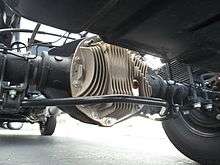10.5" Corporate 14 Bolt Differential
10.5” Corporate 14 Bolt Differential is a heavy duty differential that is used by Chevrolet and GMC trucks and vans since 1973. This differential is of the full floating design and has a ring gear with a diameter of 10.5 inches (270 mm). As the name implies, this differential has 14 bolts holding on the differential cover. The ring gear is not held on with 14 bolts, but rather 12.
General specifications
- 10.5” diameter ring gear
- Axles are 30 spline axles
- 1.590” diameter shank on the pinion
- Gear ratios: 3.21, 3.42, 3.73, 4.10, 4.56, 4.88, 5.13, and 5.38
- Carrier break: 3.21:1 - 4.11:1 and 4:56 - 5.38
- 1.50” axle spline diameter
- 1.34” axle shaft diameter
- Axles are different lengths from side to side
- Removable pinion support
- Weight: 550 pounds (250 kg)
- GAWR: 8,600 pounds (3,900 kg) Max.
- Pinion supported with bearings on both sides of the teeth (straddle mount), which minimizes pinion deflection
Design
The first design was produced from 1973 to 1984. The first design remained unchanged until 1986. This design had drums that were held on by the wheel studs and had a smaller diameter pinion bearing than the second design. The second design was produced from 1986 to present. One change that occurred in the second design was that on some models the brake drum could be removed without having to remove the hub and axle shaft. Additionally, the pinion received a larger diameter bearing while the pinion stayed the same diameter, which increased the durability of the pinion. All these axle are full floating.
Brakes
All of the 14 bolt differentials typically have drum brakes except for the newest models which have disc brakes. The first design of this differential had three different diameter brake drums. At first the differential was released with drums small enough to fit 15” wheels. Then after a few years a larger drum was standard on the ¾ ton along with the even larger drum on the 1 ton. This is an area of the axle assembly that is commonly converted by the enthusiast to disc brakes for added braking performance and lower cost of maintenance.[1]
Pinion
The pinion is supported both in front of and behind the pinion teeth,[2] an arrangement often referred to as "straddle mounting". Straddle mounting greatly reduces pinion deflection under high torque loads, conferring increased longevity and torque capacity. The pinion is also removable from the back as well making for easier access.
Re-purposing
A common modifiable choice for restoration upgrades on older Chevrolet, GMC trucks.
11.5 AAM
The 11.5 AAM rear differential replaced the "14 bolt" in many of the General Motors "heavy duty" light trucks in 2001 models, however the "14 bolt" is still in production. Besides trucks, it is used in commercial van applications. AAM continues to manufacture this axle for GM, as well as Dodge Ram trucks. Dodge discontinued running Dana Holding Corporation axles after model year 2002 trucks. This is the main axle used in 3rd Generation Dodge Ram 2500 and 3500 trucks. The GM version uses a paper gasket and the Ram version uses a re-usable rubber gasket. This attribute also makes the Dodge and GM axles appear very different, because of the different cover used. The GM AAM axle tubes are a smaller diameter then the AAM dodge's. GM also opted to have a vibration dampener installed on the yoke, while dodge opted to place the dampener on the drive shaft. This became the standard axle on all 2500 and 3500 RAM trucks for model year 2014.
Features
- Increased GAWR: 6,900 pounds (3,100 kg) Max.
- 1541 alloy axle shafts
- Larger ring and pinion than the "14 bolt" axle. As well as other components.
- Although pinion is overhung/no support bearing like the 14 bolt.
- Selectable locking differential on Ram Power Wagon (2014 and newer.)

10.5 AAM
2500 3rd Generation Dodge trucks use a 10.5 AAM in all the V8 equipped trucks. Some early model Diesel and V10 trucks also used this axle. Like the 11.5, this axle also uses a re-usable rubber gasket and looks similar to the 11.5 axle. The Ram Power Wagon also uses this axle with a locking differential. 2013 was the last model year that RAM 2500 and 3500 trucks were equipped with this axle.
See also
References
- ↑ http://www.fourwheeler.com/techarticles/drivetrain/129_1103_14_bolt_disc_brake_conversion/index.html
- ↑ Intermediate Direct Support/General Support Maintenance Manual for CUCV (TM 9-2320-289-34) (PDF). Department of the Army, the Air Force, and Headquarters, Marine Corps. 12 January 1989. pp. 6–117. Retrieved 14 October 2011.
External links
- http://www.4wheeloffroad.com/techarticles/drivetrain/131_0605_gm_14_bolt_axle_rebuild_parts/index.html
- http://www.pirate4x4.com/tech/billavista/14b_bible/index.html